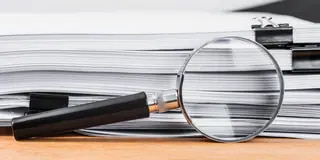Safety of Windows and Prisms Used in FTIR
A variety of windows and prisms are used in FTIR analysis. They are selected as appropriate for the sample and measurement method on the basis of their solubility with respect to the sample (particularly in the case of liquid samples), the transmission wavenumber range, and refractive index. In light of recent environmental problems, it is also important to consider the ease and safety with which windows and prisms can be used, stored, and disposed of. Here, from the perspective of safety and environmental issues, I will describe some points to consider in the selection of windows and prisms.
Window and Prism Materials
The window and prism materials mainly used in FTIR analysis include those given in Table 1. Here, we will take a look at KRS-5, zinc selenide (ZnSe), and barium fluoride (BaF2), materials that require particular care.
KRS-5
KRS-5 is a mixed crystal consisting of thallium bromide (TlBr) and thallium iodide (TlI).
As KRS-5 contains thallium, inhaling the powder produced when a KRS-5 window or prism is polished may cause intoxication. Users must not attempt to polish KRS-5 by themselves.
It is specified as a Class 2 Designated Chemical Substance by Japan's Law for Pollutant Release and Transfer Register (PRTR).
Zinc Selenide (ZnSe)
Zinc selenide is often used as a prism material. It reacts with acidic samples to produce toxic hydrogen selenide and it should only be used in the analysis of samples with pH values in the range of 6.5 to 9.5. Also, if ignited by fire or some other means, it decomposes to produce harmful fumes of selenium oxides.
It is designated as a poisonous substance (selenium compound) by Japan's Poisonous and Deleterious Substances Control Law and it is specified as a Class 1 Designated Chemical Substance by the PRTR Law.
Barium Fluoride (BaF2)
Barium fluoride is often used as the window material in analysis performed with a microscope. If it is heated or comes in contact with acid, it produces harmful hydrogen fluoride gas.
It is designated as a deleterious substance (barium compound) by the Poisonous and Deleterious Substances
Control Law and it is specified as a Class 1 Designated Chemical Substance by the PRTR Law.
Poisonous and Deleterious Substances Control Law (Japan)
Among the materials listed in Table 1, zinc selenide (poisonous substance) and barium fluoride (deleterious substance) are subject to control. I will leave interpretations of the law to more specialized documents. Here, I will describe some points related to purchase, storage management, use, and disposal that users must be careful to observe.
[Purchase Control]
- Be sure to create registers for purchased chemicals, and clearly indicate the current amounts and usage status.
[Handling of Poisonous and Deleterious Substances]
- Ascertain the physical and chemical properties, particularly the toxicity, of poisonous and deleterious substances. Regarding items that require immediate action in the event of an accident, obtain all the relevant information in advance, and maintain a state of readiness.
- Store poisonous and deleterious substances in robust medicine cabinets and chemical closets, keep these containers locked, and take any steps necessary to ensure that the substances are not stolen or lost.
- In places where stored poisonous or deleterious substances are on display, label them "not for medicinal purposes". Additionally, label poisonous substances "poisonous substances" with white letters on a red background and label deleterious substances "deleterious substances" with red letters on a white background.
[Storage Control of Chemicals]
- Store chemicals in clearly visible locations.
- Store poisonous or deleterious substances in locked containers specifically designed for this purpose.
- Clearly identify the administrators of keys, periodically check the numbers of keys, and take any other steps necessary to ensure comprehensive key management.
- Create an administrative ledger, and periodically check stocks. Perform the storage management required to prevent loss.
[Disposal Control of Poisonous and Deleterious Substances]
- Poisonous and deleterious substances cannot be disposed of without being treated.
- Either dispose of poisonous or deleterious substances using the legally specified method, such as decomposition, combustion, or neutralization, or have them disposed of by a disposal subcontractor authorized by the local authority.
[Management of Training for Handling Poisonous and Deleterious Substances]
- Periodically train personnel handling poisonous and deleterious substances with regard to the handling methods used.
Although crystalline materials such as windows and prisms are themselves subject to the Poisonous and Deleterious Substances Control Law, in cases where they are incorporated into holders or form part of the equipment in some other way, they are not. There is still the same level of danger, however, so handle such parts with due care.
| Class 1 Designated Chemical Substance |
Class 2 Designated Chemical Substance |
| Subject to PRTR and MSDS | Subject to MSDS only |
| 354 substances including the following: • Zinc selenide (selenide and its compounds) • Barium fluoride (barium and its water-soluble compounds) |
81 substances including the following: • KRS-5 (thallium and its water-soluble compounds) |
Other Laws and Regulations
There are window and prism materials that are regulated by laws and regulations other than the Poisonous and Deleterious Substances Control Law and the PRTR Law. Be sure to use these materials safely with reference to the MSDSs described later and other appropriate documentation.
MSDS
An MSDS (Material Safety Data Sheet) is a document that summarizes information about a material that includes chemical and physical properties, dangers and hazards, emergency measures for dealing with intoxication, points to note in handling, storage, and disposal, and applicable laws and regulations. If you read this, you will know how to store, use, and dispose of the applicable material.
An MSDS for a material can be obtained from the place of purchase. It can also be searched for and accessed via the Internet.
Summary
Most of the window and prism materials used in FTIR analysis are crystalline, so they do not have an immediate effect on the human body. With some materials, however, swallowing a broken fragment or inhaling abrasion powder after polishing with deficient equipment may result in intoxication. In some cases, a material may react with a chemical to produce toxic gas. In addition, there are materials for which strict management of storage and disposal is demanded by laws and regulations.
We ask that you use materials properly with reference to the applicable MSDSs and other documentation.
Table 1 Common Infrared Transmissive Materials
| Material | Transmission Wavelength Range cm-1(μm) |
Refractive Index 1000cm-1 |
Water-Solubility at 20ºC g/100 gH2O |
Properties |
| KBr (potassium bromide) |
40,000 to 340 (0.25 to 29.4) |
1.52 | 65 | Inexpensive. Large wavelength range. Good workability (using absolute alcohol). Most frequently used. Relatively strong mechanically. Must be stored at humidity of 50% or less. Cleaning: Chloroform Carbon tetrachloride Use prohibited: Samples containing water Lower alcohol |
| NaCl (sodium chloride) |
50,000 to 600 (0.2 to 16.6) |
1.49 | 36 | Most inexpensive material. Large wavelength range. Must be stored at humidity of 50% or less. Cleaning: Chloroform Carbon tetrachloride Use prohibited: Samples containing water Lower alcohol |
| KCl (potassium chloride) |
40,000 to 500 (0.25 to 20.0) |
1.46 | 34 | Similar properties to NaCl and KBr. Not commonly used. Cleaning: Chloroform Carbon tetrachloride Use prohibited: Samples containing water Lower alcohol |
| CsI (cesium iodide) |
33,000 to 200 (0.3 to 50.0) |
1.74 | 44 | Soft and easily damaged. Used in the far-infrared region. Extremely high deliquescence. Must be stored at humidity of 40% or less. Must be handled with care. Cleaning: Chloroform Carbon tetrachloride Use prohibited: Samples containing water Lower alcohol |
| KRS-5 (TlBr + TlI) (thallium bromide + thallium iodide) |
16,600 to 250 (0.6 to 40.0) |
2.37 | 0.05 | Large wavelength range. High refractive index. Most commonly used material in ATR prisms. Almost completely insoluble in water. Tl is toxic and so special treatment equipment is required for fabrication. Cleaning: Chloroform Carbon tetrachloride Xylene Use prohibited: Acetone Ammonium salt Substances that form a complex with Tl, such as sulfuric acid, ammonia water, and EDTA |
| ZnS (zinc sulfide) |
10,000 to 725 (1.0 to 13.3) |
2.2 | Insoluble | Highly resistant to water. Resistant to mechanical and thermal shocks. High refractive index. Effective for vapor deposition. Cleaning: Acetone Alcohol Use prohibited: Acidic liquids |
| ZnSe (zinc selenide) |
10,000 to 550 (1.0 to 18.1) |
2.4 | Insoluble | Highly resistant to water. Highly resistant to organic solvents, weak acids, and alkalis. Can be used in a pH range of 6.5 to 9.5. High refractive index. Effective for ATR prisms. Specified as a poisonous substance by the Poisonous and Deleterious Substances Control Law (selenide compound). If used to analyze strongly acidic samples, toxic hydrogen selenide is produced. Cleaning: Acetone Water Use prohibited: Acidic liquids Strong alkalis Formates such as Ca (HCOO)2 and NaHCOO that produce HCOO- in aqueous solutions |
| Material | Transmission Wavelength Range cm-1(μm) |
Refractive Index 1000cm-1 |
Water-Solubility at 20ºC g/100 gH2O |
Properties |
| BaF2 (barium fluoride) |
50,000 to 770 (0.2 to 12.9) |
1.42 | 0.004 | Dissolves in acids and ammonia. Can be used at temperatures up to 500ºC. Almost completely insoluble in water. Specified as a deleterious substance by the Poisonous and Deleterious Substances Control Law (barium compound). Cleaning: Acetone Water Use prohibited: Acidic liquids Ammonium salts |
| CaF2 (calcium fluoride) |
50,000 to 1,100 (0.2 to 9.0) |
1.39 | Insoluble | Dissolves in ammonium salts. Highly resistant to acids and alkalis. Hard with good mechanical strength. Suitable for the windows of high-pressure cells. Cleaning: Acetone Water Use prohibited: Strongly acidic liquids Ammonium salts |
| Si (silicon) |
8,000 to 660 (1.25 to 15.1) |
3.4 | Insoluble | Effective for semiconductors. Can be replaced with Ge as a window material. Not commonly used. Cleaning: Acetone Water Use prohibited: HF + HNO3 |
| Ge (germanium) |
5,500 to 660 (1.8 to 16.6) |
4 | Insoluble | Effective for semiconductors. Effective for vapor deposition. Can be fabricated into lenses. High refractive index; suitable for use in ATR prisms in the analysis of substances with high refractive indices. Highly resistant to water. Cleaning: Toluene Water Use prohibited: Hot concentrated sulfuric acid |
| Type ll diamond | 40,000 to 12.5 (0.25 to 800) |
2.38 | Insoluble | The hardest substance. Brittle. Although there is a low level of absorption in the range of 3,000 to 1,500 cm-1 (in the case of Type ll), it can be used in a range encompassing the ultraviolet and far-infrared regions. Natural diamonds can be classified as Type I or Type ll. Type ll is effective for infrared windows. Large-size materials are extremely expensive. Suitable for the windows of high-pressure cells. Cleaning: Ethanol Acetone |
| SiO2 (fused silica) |
50,000 to 2,500 (0.20 to 4.0) |
1.42 (3,000 cm-1) |
Insoluble | Effective for windows used in the ultraviolet and visible-light regions. In the infrared region, it only transmits wavelengths of up to 4 mm. In this range, however, it is stable, easy to fabricate, and an effective window material. Cleaning: Ethanol Acetone |






